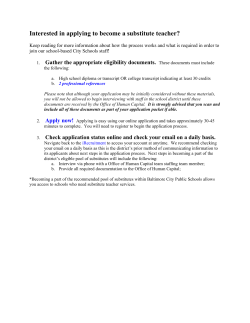
Taking the Lead with the NGSS
Taking the Lead with the NGSS NSTA National Convention Chicago, Illinois Jody Bintz BSCS Senior Science Educator Connie Hvidsten BSCS Science Educator Goal for Today • Deepen understanding of what it takes to support teachers in developing a shared vision enacting the NGSS. © 2015 BSCS Agenda • Opening • Teaching in light of the NGSS • Leading change to enact the NGSS • Closing © 2015 BSCS BSCS Mission To transform science teaching and learning through research and development that strengthens learning environments and inspires a global community of scientifically literate citizens. Focus Questions • What does it take to create a safe environment for teachers to negotiate their understandings about science teaching and learning in light of NGSS? • What principles of change guide a leader’s facilitation of transformation of teaching and learning necessary for NGSS? © 2015 BSCS Characteristics of a Community of Learners • • • • • • Shared norms and values Focus on student learning Collaboration Deprivatized practice Reflective dialogue Relational trust © 2015 BSCS Video Viewing Basics • Viewing Basic #1: Look past the trivial, the little things that “bug” you. • Viewing Basic #2: Avoid the “this doesn’t look like my classroom” trap. • Viewing Basic #3: Avoid making snap judgments about the teaching or learning in the classroom you are viewing. 7 © 2015 BSCS Connecting to real classrooms • Context: 5th students engaging in lessons related to the water cycle. • Content: This is the 4th lesson in a 6 lesson series where students are discussing their observations of water changes (see page 5 of your packet). They attempt to explain their observations in light of new knowledge about the movement of molecules during phase changes. • Watch the video and take notes: – Based on this short clip, what does this teacher know or what does he do that is in line with NGSS? – Where would you say he is on a continuum of translating NGSS to his classroom learning experiences? • Mark specific places in the transcript to point to as evidence for your claims. © 2015 BSCS What did you see? • Turn to a partner and share: – What did you see in this clip that reflects your vision of teaching and learning aligned with NGSS? (site specific timestamps in the transcript to support your thinking) – What specific teacher moves supported students in making sense and explaining of what happened in the demonstration? (cite specific timestamps in the transcript to support your thinking) © 2015 BSCS What do teachers need to know and be able to do? • Based on this short clip, create a T‐chart with your table describing What do teachers need to know to successfully enact NGSS What do teachers need to be able to do to successfully enact NGSS © 2015 BSCS Gallery Walk • What common themes emerged in the charts? • What new ideas did you get by looking at others’ charts? © 2015 BSCS Powerful Learning Experiences • THINK‐‐about a powerful learning experience in your life. – – – – What was the experience? Where were you? Who were you with? What were the elements that made the experience powerful? © 2015 BSCS Connecting to a PD experience • Context: An after‐school meeting of teachers preparing to collaboratively develop a series of lessons on the water cycle. • Content: The teachers are developing their own explanations of their observations of a beaker of water. • Watch the video and take notes: – What is the evidence that teachers were learning (or not)? – What did the PD Leader do (or not do) to help teachers negotiate their understanding of science subject matter? – Based on this short clip, what can you say about this community of learners? • Mark specific places in the transcript to point to as evidence for your claims. © 2015 BSCS Professional Learning • Additive Learning ‐‐ the addition of new skills to an existing repertoire AND • Transformative Learning ‐‐ substantial changes in deeply held beliefs, knowledge, and habits of practice Thompson, C., & Zeuli, J. (1999). The Frame and the Tapestry. In G. Sykes & L. Darling-Hammond. Teaching as the Learning Profession. San Francisco, CA: Jossey Bass. © 2015 BSCS Requirements for TRANSFORMATIVE Professional Development 1. 2. 3. 4. Create cognitive dissonance Opportunities to work to resolve dissonance Connect 1 and 2 to teacher’s students Develop a repertoire of practice to support new understanding 5. Support for recycling 1‐4 Thompson, C., & Zeuli, J. (1999). The Frame and the Tapestry. In G. Sykes & L. Darling-Hammond. Teaching as the Learning Profession. San Francisco, CA: Jossey Bass. © 2015 BSCS Additive and Transformative Learning • Read “Requirements for Transformative Professional Development” (p. 9 in your packet) • Reflect individually: – To what extent have your professional learning experiences been transformative as described in the reading? – To what extent is “transformative learning” a requirement for effective implementation of the NGSS? © 2015 BSCS Reflect © 2015 BSCS
© Copyright 2025











